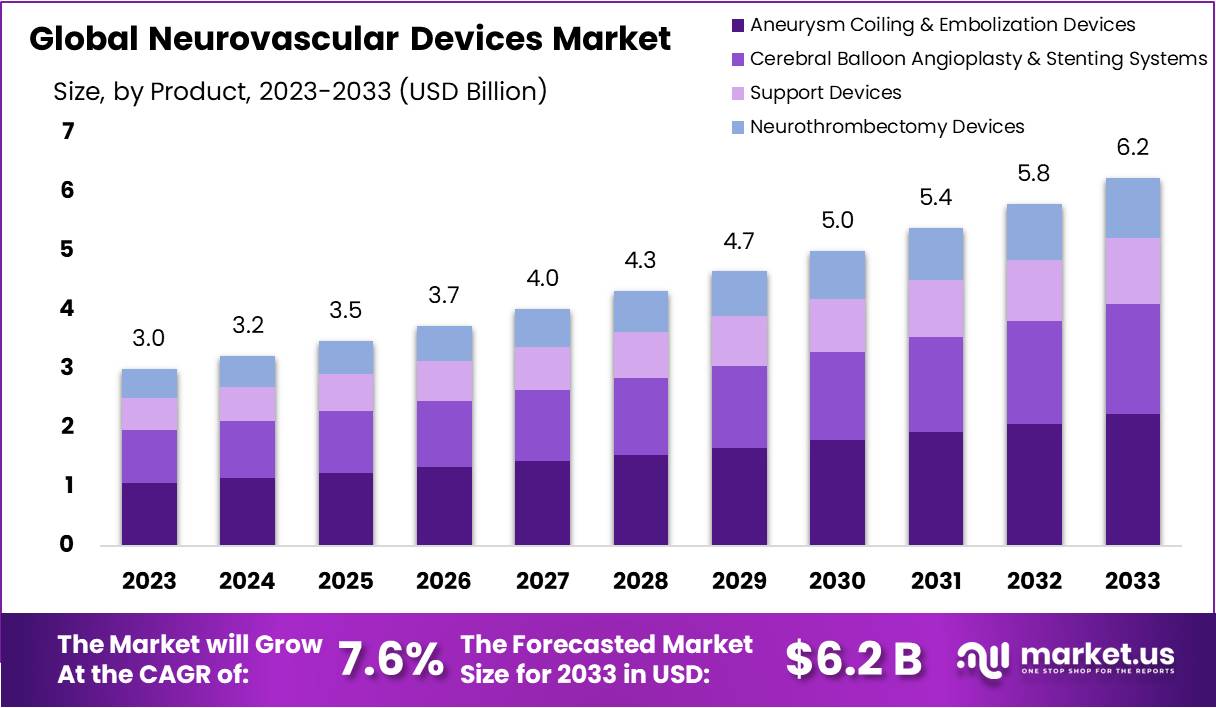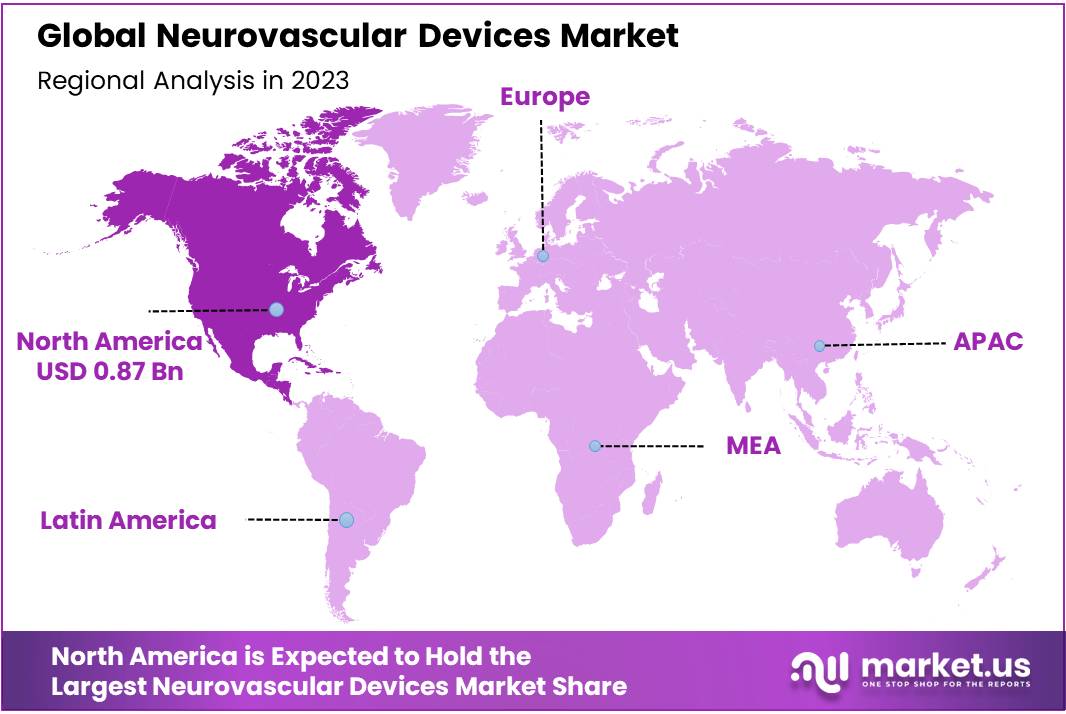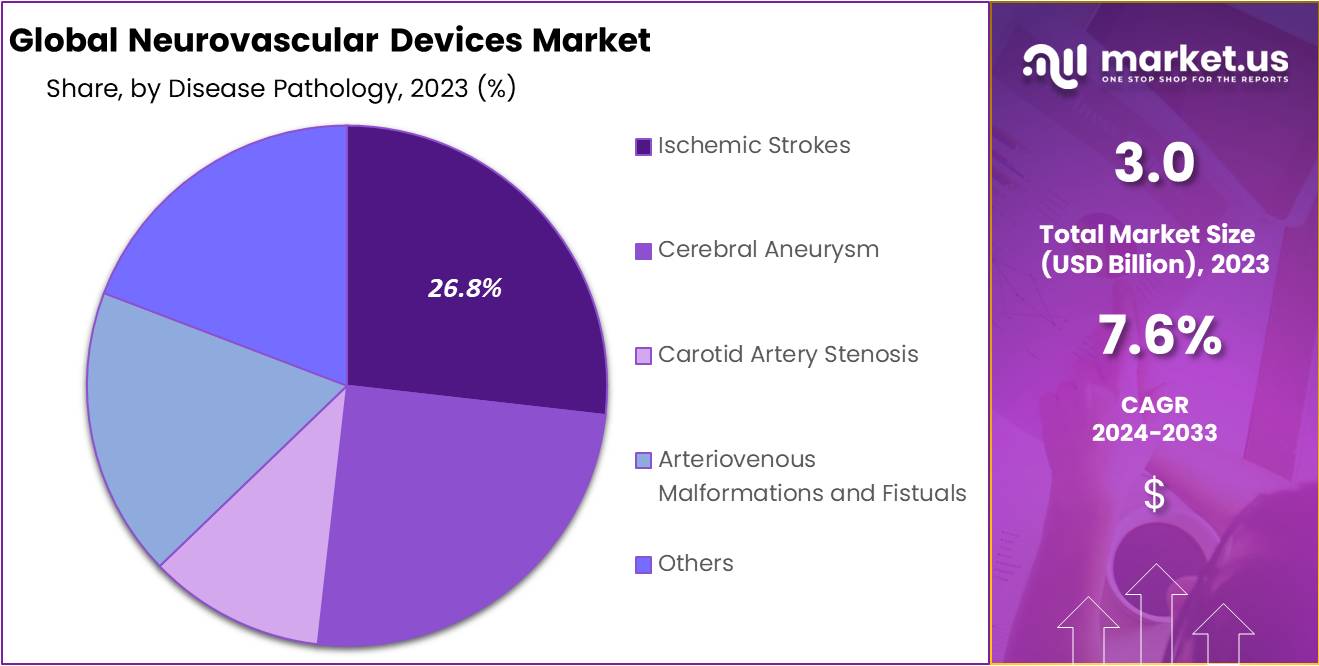New York, Feb. 07, 2024 (GLOBE NEWSWIRE) -- According to Market.us, the global Neurovascular Devices Market size is forecasted to exceed USD 6.2 Billion by 2033, with a promising CAGR of 7.6% from 2024 to 2033.
The neurovascular devices market is likely experiencing growth due to an increasing prevalence of neurological diseases, advancements in technology, and a growing preference for minimally invasive procedures. Interventional neurology devices play a crucial role in the identification and treatment of disorders affecting the vascular system of the brain and the central nervous system.
Don't miss out on business opportunities | Get sample pages at https://market.us/report/neurovascular-devices-market/request-sample/

Key Takeaway:
- The neurovascular devices market was characterized by the dominance of embolization and aneurysm-coiling devices, collectively holding a substantial market share of approximately 35.7%.
- Within disease pathology, ischemic strokes emerged as the predominant segment, underscoring the significance of devices designed to address blockages in brain blood vessels.
- The application focus was prominently on stroke treatment, capturing 58.3% of the market share in 2023, driven by the growing incidence of strokes and hypertension.
- In terms of size preference, devices with a size of 0.021" led the market, indicating a preference for specific device sizes among healthcare professionals.
- The primary end users are hospitals and surgical centers, constituting around 70.5% of the market share in 2023, reflecting the increasing patient population with neurovascular diseases.
- North America remained the leading contributor to the market, with a share of 29.2%.
Factors affecting the growth of the Neurovascular Devices market:
- The demand for immunoassays is driven by the increasing research and development activities. With the dangers associated with neurovascular diseases, the demand for effective diagnostic and therapeutic solutions is on the rise.
- While the immunoassays are highly accurate and reliable, the high costs associated with such techniques often translates to restricted accessibility, which ultimately hinders the growth of the market. The lack of skilled personnel also impacts the market negatively.
- Heightened demand for minimally invasive procedures has affected the immunoassays market in a considerable manner.
- Further, emerging nations present the global immunoassays market with a plethora of opportunities.
Top Trends in the Global Neurovascular Devices Market:
- The demand for innovative devices is being fueled by the increasing trend of minimally invasive procedures to treat neurovascular disorders. These procedures are less invasive, leading to shorter recovery times and causing less trauma to the patient.
- The popularity of flow diversion devices, such as Pipeline Embolization Devices, is on the rise for treating complex aneurysms. These devices divert blood flow away, promoting the formation of a blood clot inside the aneurysm.
- A rising incidence of aneurysms and strokes is expected to drive significant growth in the Asia-Pacific region. Emerging markets like China and India are anticipated to be key drivers of this growth.
- Companies are making substantial investments in research and development to create innovative devices that can improve patient outcomes. Some companies are developing devices that leverage artificial intelligence for the diagnosis and treatment of neurological disorders.
Market Growth:
The neurovascular devices market is poised for substantial growth driven by several key factors. The increasing incidence of neurological diseases, coupled with technological advancements and a growing interest in minimally invasive procedures, is bolstering the demand for neurovascular devices. The shift toward therapeutic options that reduce patient risks and severity of neurovascular diseases underscores the necessity for efficient treatments. However, challenges such as high costs, stringent regulatory environments, and a shortage of skilled healthcare professionals pose hurdles to market expansion.
Despite these challenges, the market is witnessing notable trends, including the rising adoption of multiplex immunoassays, integration of artificial intelligence for data analysis, and advancements in point-of-care testing. Opportunities lie in untapped markets, especially in developing regions, and the potential for customization to individual patient profiles. Overall, the neurovascular devices market is positioned for growth, driven by a combination of technological innovation, increasing disease prevalence, and evolving healthcare landscapes.
Macroeconomic Factors:
The neurovascular devices market is influenced by several macroeconomic factors that shape its trajectory. Economic stability and healthcare expenditure play pivotal roles, determining the affordability and accessibility of neurovascular devices. Regulatory policies and approval processes impact the market's dynamics, with stringent regulations potentially slowing down product development and market entry. Additionally, the availability of skilled healthcare professionals is crucial for the successful implementation of neurovascular procedures.
Global economic trends and geopolitical factors can also influence the market, affecting investment decisions, research and development activities, and international trade in neurovascular devices. As economies evolve, so too does the landscape for neurovascular devices, making it imperative for market players to navigate these macroeconomic factors effectively.
Regional Analysis:
North America is projected to dominate the neurovascular devices market in 2023 with a share of 29.2 %. This dominance is attributed to the increasing prevalence of various neurological conditions, higher rates of diagnosis and treatment, rising healthcare expenditure supporting neurological care services, and adequate reimbursement. In Europe, a sizable market share is expected due to factors such as growing awareness about managing neurovascular conditions, product launches tailored for treatment, and efforts by key market players to expand their geographic presence.
Uncover the actionable insights tailored for your business strategy. Request our brochure to learn more https://market.us/report/neurovascular-devices-market/#inquiry

Scope of the Report
| Report Attributes | Details |
| Market Value (2023) | USD 3.0 Billion |
| Forecast Revenue 2033 | USD 6.2 Billion |
| CAGR (2024 to 2033) | 7.6% |
| North America Revenue Share | 29.2% |
| Base Year | 2023 |
| Historic Period | 2018 to 2022 |
| Forecast Year | 2024 to 2033 |
Market Drivers:
Neurosurgeons and medical professionals are increasingly focused on therapeutic options that can mitigate the risk of mortality or severity of neurovascular diseases in patients. The demand for effective neurovascular therapies is growing in key markets, driven by an expanding patient population experiencing neurovascular complications and an escalation in the severity of medical conditions among target patients. A notable example is the prevalence of brain aneurysms, a significant neurovascular condition with a substantial risk of hemorrhage or enduring brain impairment.
Market Restraints:
The high cost associated with neurovascular devices poses a limitation on their accessibility, especially in low or middle-income countries, resulting in reduced demand for these devices. Companies in the neurovascular market also encounter challenges due to a stringent regulatory environment, which entails significant costs and time for obtaining approvals. The varying regulatory requirements across different regions further complicate the process of launching devices in multiple markets.
Additionally, there is a shortage of skilled healthcare professionals proficient in performing neurovascular procedures. The success of these procedures depends heavily on the expertise and experience of healthcare providers, but certain areas face a shortage of neurologists and surgeons with the necessary skills.
Market Opportunities:
Minimally Invasive Medical Procedures offer numerous advantages over traditional surgical procedures, including shorter hospital stays, quicker patient recovery, enhanced procedural safety and efficacy, and more affordable costs. The acceptance of endoscopic surgery and other minimally invasive procedures is growing among medical professionals worldwide.
Access Now for Quick Delivery | Buy Our Premium Research Report https://market.us/purchase-report/?report_id=21060
Report Segmentation of the Neurovascular Devices Market:
Technology Insight
In terms of technology, the Neurovascular Devices market is categorized into Aneurysm Coiling & Embolization Devices, Cerebral Balloon Angioplasty and Stenting Systems, Support Devices, and Neurothrombectomy Devices. Among these segments, embolization devices and aneurysm-coiling devices held a dominant position in the market, with a share of 35.7%.
Disease Pathology Insight
In terms of Disease Pathology, the Neurovascular Devices market is segmented into Ischemic Strokes, Cerebral Aneurysms, Carotid Artery Stenosis, Arteriovenous Malformations, and Fistulas. The Ischemic Strokes segment maintained a stronghold on the market, reaching a revenue share of 26.8%. Ischemic stroke occurs when a blood vessel in the brain becomes blocked, preventing blood and oxygen from reaching the affected area of the brain.

Size Insight
In terms of Size, the Neurovascular Devices Market is segmented into 0.027″, 0.021″, 0.071″, 0.017″, 0.019″, 0.013″, 0.058″, 0.068″; among these size segments, 0.021" sizes dominated the market. In 2023, the 0.021" size had the largest market share, accounting for about 29.1%. The dominance of this segment can be attributed to several benefits offered by 0.021" devices, as well as numerous product releases and approvals.
Application Insight
In terms of Application, the Neurovascular Devices market is segmented into Stroke, Cerebral Artery Cerebral Aneurysm. Among these segments, the Stroke segment dominated the market. In 2023, the stroke market is expected to account for the highest share of 58.3%. This dominance is attributed to factors such as the rising prevalence of hypertension, strokes, and other neurological diseases.
End-Use Insight
In terms of End Users, the Neurovascular Devices market is segmented into Hospitals & Surgical Centers, Ambulatory Care Centers, Research Laboratories & Academic Institutes; among these, the Hospital segment held the largest share of the market in 2023, at around 70.5%. The growth of this segment can be attributed to the increasing number of patients suffering from neurovascular diseases, including ischemic and hemorrhagic stroke, brain aneurysms, traumatic brain injury (TBI), and arteriovenous malformation (AVM).
Want to Access the Statistical Data and Graphs, Request PDF Sample @ https://market.us/report/neurovascular-devices-market/request-sample/
Recent Development of the Neurovascular Devices Market:
- In June 2022, MicroPort Scientific Corporation achieved a milestone by completing the first commercial implantation in the U.S. of its self-developed numen coil Embolization System. These advancements underscore the industry's commitment to enhancing stroke interventions and neurovascular care.
- In September 2022, Penumbra, Inc. announced the European launch of RED Reperfusion Catheters, focusing on improving stroke treatment.
- In October 2022, Medtronic introduced the Neurovascular Co-Lab Platform with the aim of expediting crucial innovations in stroke treatment and care.
Market Segmentation:
Based on Technology
- Aneurysm Coiling & Embolization Devices
-
- Embolic Coils
- Flow Diversion Devices
- Liquid Embolic Agents
- Cerebral Balloon Angioplasty & Stenting Systems
-
- Carotid Artery stents
- Embolic Protection devices
- Balloon Catheters
- Support Devices
-
- Microcatheters
- Guidewires
- Neurothrombectomy Devices
-
- Clot Retrievals
- Suction & Aspiration Devic
- Snares
- Other Technologies
By Disease Pathology
- Ischemic Strokes
- Cerebral Aneurysm
- Carotid Artery Stenosis
- Arteriovenous Malformations and Fistuals
- Other Diseases
By Size
- 0.027″
- 0.021″
- 0.071″
- 0.017″
- 0.019″
- 0.013″
- 0.058″
- 0.068″
- Other Size
By Application
- Stroke
- Cerebral Artery
- Cerebral Aneurysm
- Aneurysmal Subarachnoid hemorrhage
- Others
- Other Applications
By End User
- Hospitals & Surgical Centers
- Ambulatory Care Centers
- Research Laboratories & Academic Institutes
- Other End Users
By Geography
- North America
- US
- Canada
- Europe
- Germany
- France
- The UK
- Spain
- Italy
- Russia
- Netherland
- Rest of Europe
- Asia Pacific
- China
- Japan
- South Korea
- India
- New Zealand
- Singapore
- Thailand
- Vietnam
- Rest of APAC
- Latin America
- Brazil
- Mexico
- Rest of Latin America
- Middle East & Africa
- South Africa
- Saudi Arabia
- UAE
- Rest of MEA
Competitive Landscape:
The competitive landscape in the neurovascular devices market is characterized by key players striving for innovation and market expansion. Major companies such as Medtronic, Penumbra, Inc., and MicroPort Scientific Corporation are actively engaged in launching advanced products to address the increasing demand for neurovascular interventions. These companies focus on developing cutting-edge technologies, including flow diversion devices and reperfusion catheters, to cater to complex neurological conditions. With a strong emphasis on research and development, these players aim to maintain a significant market share, leveraging their expertise in providing solutions for minimally invasive procedures and contributing to the growth of the neurovascular devices market.
Market Key Players:
- Medtronic plc
- Johnson and Johnson Services Inc.
- Penumbra, Inc
- Microport Scientific Corporation,
- Stryker
- Microvention Inc.
- Codman Neuro
- Abbott
- Terumo Corporation
- Medilit Co. Ltd.
- Evasc
- Rapid Medical
- Other Market Players
Explore More Life Science Market Research Reports
- Neurovascular Catheters Market size is expected to be worth around USD 7.5 Billion by 2033 from USD 3.4 Billion in 2023.
- Neurovascular Guidewires Market size is expected to be worth around USD 519.1 Million by 2033 from USD 331.1 Million in 2023
- Atherectomy Devices Market was valued at USD 1.2 bn in 2022 and is expected to reach USD 2.5 bn in 2032 at a CAGR of 8% during 2023-2032.
- Medical Tubing Market was valued at USD 9.8 Bn in 2022 and is expected to reach around USD 20.4 Bn in 2032 and register a CAGR of 7.8%.
- Dry Eye Syndrome market size is expected to be worth around US$ 7,940 Mn by 2032 from US$ 4,540 Mn in 2022, growing at a CAGR of 5.9%
- Silver-based Antimicrobial Agent Market is projected to be US$ 1,080.9 Mn in 2018 to reach US$ 1,967.5 Mn by 2028 at a CAGR of 6.2%
- Air Aid Endotracheal Tube Holder Market is projected to be US$ 203.0 Mn in 2018 to reach US$ 326.4 Mn by 2028 at a CAGR of 4.9%.
- Constant Velocity Universal Joint market is projected to be USD 7,942.5 Mn in 2022 to reach USD 10,976.7 Mn by 2032 at a CAGR of 3.7%.
- Aesthetic Needles & Cannulas Market was valued at UЅD $312.2 Мn in 2020, and is projected to register а САGR of 7.5% over the next 10 years.
- US Respiratory Disposable Devices Market is projected to be USD 531.7 Mn in 2022 to reach USD 1,095.2 Mn by 2032 at a CAGR of 7.5%.
About Us:
Market.US (Powered by Prudour Pvt Ltd) specializes in in-depth market research and analysis and has been proving its mettle as a consulting and customized market research company, apart from being a much sought-after syndicated market research report-providing firm. Market.US provides customization to suit any specific or unique requirement and tailor-makes reports as per request. We go beyond boundaries to take analytics, analysis, study, and outlook to newer heights and broader horizons.
Follow Us on LinkedIn
Our Blog:
